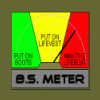Leaderboard
Popular Content
Showing content with the highest reputation on 08/25/2011 in all areas
-
And is your point that because you have a lot of EMS experience you're excused from having to make logical and coherrent arguments? I will agree that TNK and D50W are different drugs, with different indications / contraindications / safety profiles / spellings / pronounciations / scrabble triple-word-score values. Of course there's a world of difference. The point is, I give medications because there's an indication, not because I have a paranoid fantasy that my glucometer is inaccurate. If we just give D50W to patients that are unconscious and sweaty, should I even bother checking the blood sugar in unconscious patients any more? Are we saving the glucometer for identifying HHNC / DKA now? And if I see a high value, am I now going to worry that I'm inappropriately treating the patient because the glucometer was actually inaccurate? The likelihood of the patient being unresponsive due to another etiology seems greater than the probability that today is the day that my glucometer has decided not only not to work, but to report a falsely high value. No, because the sensitivity of the 12-lead ECG for myocardial infarction is approximately 40%, therefore the absence of ST changes has a low negative predicitive value. The patient gets both ASA and NTG. But I'm not going to assume that the 12-lead is giving me a false-negative, push a bunch of enoxaparin and tNK and give the patient plavix. My glucometer is sensitive for hypoglycemia, my 12-lead is relatively insensitive for myocardial infarction. Both machines are quite reliable. The ECG has a low negative-predicitive value, and therefore can't be used to rule out infarction. The glucometer has a high negative predictive value. It's a useful rule-out tool. Sounds like a medication noncompliance issue. ---------------------------------------- [Edit] On a different point, cardiac biomarkers are probably an awesome tool to have for identifying NSTEMI patients who could benefit from transport to a facility capable of PCI, but they have no role in deciding whether a patient is eligible for thrombolysis.2 points
-
I've always thought that after the initial and secondary patient assessment, we followed up with what's known as a 'continuing assessment' to provide the results of our treatments and to trend the patients condition. It is during these 'ongoing assessments' that the modality of our treatments may or may not change. I haven't seen a posting to this thread that advocates the "Let's try this and see what happens!" mentality. The responses that disprove Crotchity's premise of "I know everything NOT in the book!" seem to be based on solid evidence, rather than conjecture. Crotchity, Since you know 'everything NOT in the book", why haven't you followed through with your responsibility to furthering the field of pre-hospital care, and begun to publish what the rest of us obvious idiots don't know? While I've got some experience in a really major EMS system (I think metro Detroit qualifies as 'really major EMS system') I'm far from ever being confused with any MENSA members, (past or present); but I would be willing to follow the teachings/orders/directions/ advice of the respected physicians that are assoiciated with this forum (i.e.: Dr. Bledsoe, ERDoc, Doc 'Zilla, et al) and the guidance of the 'rock star members' that obviously know more than this mere 'medic student' will ever know. Sure, equipment fails, it has its limitations, but given that we mere mortals do not have xray vision, clairvoyance and the God like power to heal by touch, I'm going to have to rely on those electronic devices to help guide me in the treatment of my patients. They are not the sole source I base my treatments on, (thats where education comes into play),but they ARE developed and used to help diagnose whats wrong with our patients.2 points
-
So what do you think would be the ramifications of just resorting back to BLS/defib/pace with airway support and transporting? If medications haven't shown to improve outcomes then why do something that hasn't been proven to truly benefit patients. I have always wondered why in EMS we continue to do things the "old" way and not embraced evidence based items? Is it that it's always been done this way so we can't stop it because it would prove us wrong? or what?1 point
-
It depends on the patient. Generally speaking acidosis is better tolerated than alkalosis. If you have an elderly COPD patient who normally has a high baseline PaCO2 (although you would again need an ABG to confirm this) you probably won't want to bag the hell out if them to get their EtCO2 down as you run a number of risks. For asthmatic patients I basically don't worry too much about the EtCO2. I want to oxygenate them well first of all, then ventilate. I have seen EtCO2 up around 180mmHg in acutely unwell, intubated asthmatics. You will bring that number down, but you need to be careful when doing it. Hypoxia kills, hypercapnia happens. If you try to chase numbers too quickly you will end up breath stacking, causing barotrauma, popping blebs and generally causing all kinds of mischief. Slow and steady is the key here, these aren't the same as the metabolic acidosis patients first described and they will tolerate that acidosis well for some time.1 point
-
Well, there's no question that vec alone will get you intubating conditions. But it's a little committing. If you can't intubate you're left with a paralysed patient with a rescue airway device that may not be that great for preventing aspiration. Midazolam as a sedative is going to be dangerous / contraindicated in hypotensive patients. And it's probably going to make some of your normotensive patients quite hypotensive, depending on the dose. Which might not be good for them. Not having analgesia is going to produce a stress response and sympathetic output that won't be good for your patients with elevated ICP. It seems like adding fentanyl to the protocol would be a good idea. It would also allow the midazolam dose to be decreased.1 point
-
I have to disagree with intubating and leaving the tube open to air. You have just increased the work of breathing significantly in someone who is already demonstrating a presumed compensatory mechanism to acidosis. This is setting this patient up for imminent respiratory failure and potentially cardiac arrest as his acidosis increases. This patient needs inspiratory support to reduce his fatigue (and acid production and PEEP to improve ventilation to ensure that CO2 gets out of there. EtCO2, in the absence of in-field ABG is indeed what we should be using as a target for post-intubation ventilation management, with an understanding that there are going to be differences between EtCO2 and PaCO2. However this gradient is dynamic, so again, without ABG we just have to make an educated guess and get on with it. Respiratory rate is not of tertiary concern, it is one of your primary concerns in this patient as RR is what dictates ventilation, and ventilation in this patient is of paramount importance. We don't increase ventilation by increasing tidal volume; all that does is cause lung injury. If we want to improve oxygenation with just a BVM, we have 2 options: an FiO2 of .21 or an FiO2 of 1. Not ideal, but if that is what we have to work with, then we just have to make the best of it. I'm not sure what the 'dangers' of positive pressure ventilation are. Sure, there are some downsides, like a decrease in venous return from the increased intra-thoracic pressure affecting perfusion, but this can be remedied with some fluid and/or pressors. The dangers of leaving this patient breathing on his own are much greater. If you had a PEEP valve on your BVM and could try to synchronise some support with their respirations you may be able to support them, but I have always found this to be rather difficult.1 point
-
I don't know about everybody else, but I've NEVER had a problem shaving anybody, for defibrillation or for 12-Lead acquisition, with the 15 cent, single bladed disposable razor that my company provides us in our monitors. Sure, you need to knock the hair out every few strokes (swiping it backwards across a towel, or the pt's shirt, or the carpet, or whatever, works well for this), but they're quite effective, in my opinion.1 point
-
"Your patient may not have read the same textbook as you." What's wrong with your patient may not be as obvious as when you practiced scenarios in class. Look out for subtle clues. Also, your patient won't always immediately present as being obviously Big Sick. Be especially cautious with patients that are "slightly off" as that may be due to hypoxia or hypotension. That said, it's hard to be perceptive when we run so many BS calls. Somewhat related...1 point
-
If you have never seen a hypoglyemic pt present with stroke like symptoms then you haven't seen very many pts. It is one of the stroke mimics and is the reason we get a blood sugar before even thinking about tPA. Aspirin does not reduce blood clotting. If you think you are giving ASA in an MI to reduce pain then you might want to go back to basic pharmacology. You are not getting any help from the "veterans" because you are wrong. Please stop posting such inaccurate, bordering on false, information.1 point
-
To echo everything above.. Unless your intubating for primarily "respiratory" reasons, the post-intubation ventilation target should be to match the pre-intubation ventilation status. The easiest way to do this with what's described is match ETCO2. The patient will need support, as you've significantly raised the patients WOB. To tniuqs or chbare, in the absence of a vent, would allowing the patient to breathe spontaneously through something like a Jackson Rees with a spring PEEP valve be better than trying to Ambu bag the hell out of him? My gut instinct is no, your looking at further bumping WOB because there's no inspiratory support, but stuffs not always as intuitive at it seems.1 point
-
Well lets hope that if they black list them they are the ones punished. You cant make them socialize off hours or be best friends but I would hope that the guys are mature enough to work WITH them.1 point
-
Dwayne, from a respiratory point of view, intubation will significantly increase airway resistance. Add this onto a patient who may already be fatigued from working so hard to compensate along with the underlying electrolyte derangements, and this patient will likely require some type of support. Clearly, the scenario does not call for a ventilator, but this patient will need ventilatory support. Often, when we are forced to intubate DKA patients, they are fatigued to the point of exhaustion and a full support mode may be required while we fix the metabolic and underlying electrolyte derangements. At a later time we can place the patient into a "spontaneous" mode for liberation and a spontaneous breathing trial when we have re-established homeostasis; however, spontaneous modes still provide support in the form of CPAP and PS. T1 point
-
Off topic, but some perspective. Often, people with compensatory respiratory patterns who require intubation require full support modes of ventilation such as assist control to ensure they can maintain respiratory compensation. I've seen a few poorly managed DKA patients where flight crews intubated and ventilated with "normal" rates and "normal" PeCo2's. Clearly, these patients had significantly deteriorated metabolic and acid/base wise from their initial presentation.1 point





